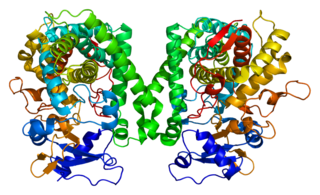Related Research Articles

Eicosanoids are signaling molecules made by the enzymatic or non-enzymatic oxidation of arachidonic acid or other polyunsaturated fatty acids (PUFAs) that are, similar to arachidonic acid, around 20 carbon units in length. Eicosanoids are a sub-category of oxylipins, i.e. oxidized fatty acids of diverse carbon units in length, and are distinguished from other oxylipins by their overwhelming importance as cell signaling molecules. Eicosanoids function in diverse physiological systems and pathological processes such as: mounting or inhibiting inflammation, allergy, fever and other immune responses; regulating the abortion of pregnancy and normal childbirth; contributing to the perception of pain; regulating cell growth; controlling blood pressure; and modulating the regional flow of blood to tissues. In performing these roles, eicosanoids most often act as autocrine signaling agents to impact their cells of origin or as paracrine signaling agents to impact cells in the proximity of their cells of origin. Some eicosanoids, such as prostaglandins, may also have endocrine roles as hormones to influence the function of distant cells.

Cytochromes P450 are a superfamily of enzymes containing heme as a cofactor that mostly, but not exclusively, function as monooxygenases. In mammals, these proteins oxidize steroids, fatty acids, and xenobiotics, and are important for the clearance of various compounds, as well as for hormone synthesis and breakdown, steroid hormone synthesis, drug metabolism, and the biosynthesis of defensive compounds, fatty acids, and hormones. CYP450 enzymes convert xenobiotics into hydrophilic derivatives, which are more readily excreted. In almost all of the transformations that they catalyze, P450's affect hydroxylation.
The epoxyeicosatrienoic acids or EETs are signaling molecules formed within various types of cells by the metabolism of arachidonic acid by a specific subset of cytochrome P450 enzymes termed cytochrome P450 epoxygenases. These nonclassic eicosanoids are generally short-lived, being rapidly converted from epoxides to less active or inactive dihydroxy-eicosatrienoic acids (diHETrEs) by a widely distributed cellular enzyme, soluble epoxide hydrolase (sEH), also termed epoxide hydrolase 2. The EETs consequently function as transiently acting, short-range hormones; that is, they work locally to regulate the function of the cells that produce them or of nearby cells. The EETs have been most studied in animal models where they show the ability to lower blood pressure possibly by a) stimulating arterial vasorelaxation and b) inhibiting the kidney's retention of salts and water to decrease intravascular blood volume. In these models, EETs prevent arterial occlusive diseases such as heart attacks and brain strokes not only by their anti-hypertension action but possibly also by their anti-inflammatory effects on blood vessels, their inhibition of platelet activation and thereby blood clotting, and/or their promotion of pro-fibrinolytic removal of blood clots. With respect to their effects on the heart, the EETs are often termed cardio-protective. Beyond these cardiovascular actions that may prevent various cardiovascular diseases, studies have implicated the EETs in the pathological growth of certain types of cancer and in the physiological and possibly pathological perception of neuropathic pain. While studies to date imply that the EETs, EET-forming epoxygenases, and EET-inactivating sEH can be manipulated to control a wide range of human diseases, clinical studies have yet to prove this. Determination of the role of the EETS in human diseases is made particularly difficult because of the large number of EET-forming epoxygenases, large number of epoxygenase substrates other than arachidonic acid, and the large number of activities, some of which may be pathological or injurious, that the EETs possess.

Cytochrome P4502C8 (CYP2C8) is a member of the cytochrome P450 mixed-function oxidase system involved in the metabolism of xenobiotics in the body. Cytochrome P4502C8 also possesses epoxygenase activity, i.e. it metabolizes long-chain polyunsaturated fatty acids, e.g. arachidonic acid, eicosapentaenoic acid, docosahexaenoic acid, and Linoleic acid to their biologically active epoxides.

Cytochrome P450 2J2 (CYP2J2) is a protein that in humans is encoded by the CYP2J2 gene. CYP2J2 is a member of the cytochrome P450 superfamily of enzymes. The enzymes are oxygenases which catalyze many reactions involved in the metabolism of drugs and other xenobiotics) as well as in the synthesis of cholesterol, steroids and other lipids.

Cytochrome P450 2C18 is a protein that in humans is encoded by the CYP2C18 gene.

Cytochrome P450 4A11 is a protein that in humans is codified by the CYP4A11 gene.

Cytochrome P450 4F8 is a protein that in humans is encoded by the CYP4F8 gene.

Cytochrome P450 4F12 is a protein that in humans is encoded by the CYP4F12 gene.

Cytochrome P450 4F3, also leukotriene-B(4) omega-hydroxylase 2, is an enzyme that in humans is encoded by the CYP4F3 gene. CYP4F3 encodes two distinct enzymes, CYP4F3A and CYP4F3B, which originate from the alternative splicing of a single pre-mRNA precursor molecule; selection of either isoform is tissue-specific with CYP3F3A being expressed mostly in leukocytes and CYP4F3B mostly in the liver.
Epoxygenases are a set of membrane-bound, heme-containing cytochrome P450 enzymes that metabolize polyunsaturated fatty acids to epoxide products that have a range of biological activities. The most thoroughly studied substrate of the CYP epoxylgenases is arachidonic acid. This polyunsaturated fatty acid is metabolized by cyclooxygenases to various prostaglandin, thromboxane, and prostacyclin metabolites in what has been termed the first pathway of eicosanoid production; it is also metabolized by various lipoxygenases to hydroxyeicosatetraenoic acids and leukotrienes in what has been termed the second pathway of eicosanoid production. The metabolism of arachidonic acid to epoxyeicosatrienoic acids by the CYP epoxygenases has been termed the third pathway of eicosanoid metabolism. Like the first two pathways of eicosanoid production, this third pathway acts as a signaling pathway wherein a set of enzymes metabolize arachidonic acid to a set of products that act as secondary signals to work in activating their parent or nearby cells and thereby orchestrate functional responses. However, none of these three pathways is limited to metabolizing arachidonic acid to eicosanoids. Rather, they also metabolize other polyunsaturated fatty acids to products that are structurally analogous to the eicosanoids but often have different bioactivity profiles. This is particularly true for the CYP epoxygenases which in general act on a broader range of polyunsaturated fatty acids to form a broader range of metabolites than the first and second pathways of eicosanoid production. Furthermore, the latter pathways form metabolites many of which act on cells by binding with and thereby activating specific and well-characterized receptor proteins; no such receptors have been fully characterized for the epoxide metabolites. Finally, there are relatively few metabolite-forming lipoxygenases and cyclooxygenases in the first and second pathways and these oxygenase enzymes share similarity between humans and other mammalian animal models. The third pathway consists of a large number of metabolite-forming CYP epoxygenases and the human epoxygenases have important differences from those of animal models. Partly because of these differences, it has been difficult to define clear roles for the epoxygenase-epoxide pathways in human physiology and pathology.

CYP4F11 is a protein that in humans is encoded by the CYP4F11 gene. This gene encodes a member of the cytochrome P450 superfamily of enzymes. The cytochrome P450 proteins are monooxygenases which catalyze many reactions involved in drug metabolism and synthesis of cholesterol, steroids and other lipids. This gene is part of a cluster of cytochrome P450 genes on chromosome 19. Another member of this family, CYP4F2, is approximately 16 kb away. Alternatively spliced transcript variants encoding the same protein have been found for this gene.

CYP4A22 also known as fatty acid omega-hydroxylase is a protein which in humans is encoded by the CYP4A22 gene.

CYP2U1 is a protein that in humans is encoded by the CYP2U1 gene

15-Hydroxyeicosatetraenoic acid (also termed 15-HETE, 15(S)-HETE, and 15S-HETE) is an eicosanoid, i.e. a metabolite of arachidonic acid. Various cell types metabolize arachidonic acid to 15(S)-hydroperoxyeicosatetraenoic acid (15(S)-HpETE). This initial hydroperoxide product is extremely short-lived in cells: if not otherwise metabolized, it is rapidly reduced to 15(S)-HETE. Both of these metabolites, depending on the cell type which forms them, can be further metabolized to 15-oxo-eicosatetraenoic acid (15-oxo-ETE), 5(S),15(S)-dihydroxy-eicosatetraenoic acid (5(S),15(S)-diHETE), 5-oxo-15(S)-hydroxyeicosatetraenoic acid (5-oxo-15(S)-HETE), a subset of specialized pro-resolving mediators viz., the lipoxins, a class of pro-inflammatory mediators, the eoxins, and other products that have less well-defined activities and functions. Thus, 15(S)-HETE and 15(S)-HpETE, in addition to having intrinsic biological activities, are key precursors to numerous biologically active derivatives.

20-Hydroxyeicosatetraenoic acid, also known as 20-HETE or 20-hydroxy-5Z,8Z,11Z,14Z-eicosatetraenoic acid, is an eicosanoid metabolite of arachidonic acid that has a wide range of effects on the vascular system including the regulation of vascular tone, blood flow to specific organs, sodium and fluid transport in the kidney, and vascular pathway remodeling. These vascular and kidney effects of 20-HETE have been shown to be responsible for regulating blood pressure and blood flow to specific organs in rodents; genetic and preclinical studies suggest that 20-HETE may similarly regulate blood pressure and contribute to the development of stroke and heart attacks. Additionally the loss of its production appears to be one cause of the human neurological disease, Hereditary spastic paraplegia. Preclinical studies also suggest that the overproduction of 20-HETE may contribute to the progression of certain human cancers, particularly those of the breast.

Epoxide docosapentaenoic acids are metabolites of the 22-carbon straight-chain omega-3 fatty acid, docosahexaenoic acid (DHA). Cell types that express certain cytochrome P450 (CYP) epoxygenases metabolize polyunsaturated fatty acids (PUFAs) by converting one of their double bonds to an epoxide. In the best known of these metabolic pathways, cellular CYP epoxygenases metabolize the 20-carbon straight-chain omega-6 fatty acid, arachidonic acid, to epoxyeicosatrienoic acids (EETs); another CYP epoxygenase pathway metabolizes the 20-carbon omega-3 fatty acid, eicosapentaenoic acid (EPA), to epoxyeicosatetraenoic acids (EEQs). CYP epoxygenases similarly convert various other PUFAs to epoxides. These epoxide metabolites have a variety of activities. However, essentially all of them are rapidly converted to their corresponding, but in general far less active, vicinal dihydroxy fatty acids by ubiquitous cellular soluble epoxide hydrolase. Consequently, these epoxides, including EDPs, operate as short-lived signaling agents that regulate the function of their parent or nearby cells. The particular feature of EDPs distinguishing them from EETs is that they derive from omega-3 fatty acids and are suggested to be responsible for some of the beneficial effects attributed to omega-3 fatty acids and omega-3-rich foods such as fish oil.

Epoxyeicosatetraenoic acids are a set of biologically active epoxides that various cell types make by metabolizing the omega 3 fatty acid, eicosapentaenoic acid (EPA), with certain cytochrome P450 epoxygenases. These epoxygenases can metabolize EPA to as many as 10 epoxides that differ in the site and/or stereoisomer of the epoxide formed; however, the formed EEQs, while differing in potency, often have similar bioactivities and are commonly considered together.
Cytochrome P450 omega hydroxylases, also termed cytochrome P450 ω-hydroxylases, CYP450 omega hydroxylases, CYP450 ω-hydroxylases, CYP omega hydroxylase, CYP ω-hydroxylases, fatty acid omega hydroxylases, cytochrome P450 monooxygenases, and fatty acid monooxygenases, are a set of cytochrome P450-containing enzymes that catalyze the addition of a hydroxyl residue to a fatty acid substrate. The CYP omega hydroxylases are often referred to as monoxygenases; however, the monooxygenases are CYP450 enzymes that add a hydroxyl group to a wide range of xenobiotic and naturally occurring endobiotic substrates, most of which are not fatty acids. The CYP450 omega hydroxylases are accordingly better viewed as a subset of monooxygenases that have the ability to hydroxylate fatty acids. While once regarded as functioning mainly in the catabolism of dietary fatty acids, the omega oxygenases are now considered critical in the production or break-down of fatty acid-derived mediators which are made by cells and act within their cells of origin as autocrine signaling agents or on nearby cells as paracrine signaling agents to regulate various functions such as blood pressure control and inflammation.
Jorge H. Capdevila is an American biochemist and professor emeritus of Medicine at Vanderbilt University Medical School, Nashville, TN. He was named a Fellow of the American Heart Association in 2002 and received the 2004 American Heart Association's “Novartis Excellence Award for Hypertension Research” for his contributions to our understanding of the molecular basis of hypertension. Capdevila's pioneering identification of roles for the Cytochrome P450 (P450) enzymes in the metabolism of arachidonic acid (AA) and of the physiological and pathophysiological importance of these enzymes and products was recognized in a special section honoring him at the 14th International Winter Eicosanoid Conference, Baltimore, MD, March 11–14, 2012. Capdevila received an “Outstanding Achievement Award” from the Eicosanoid Research Foundation at their 15th International Bioactive Lipid Conference in Puerto Vallarta, Mexico, on October 22–25, 2017, and is listed as a noteworthy medical and biochemical educator in the 2008 62nd volume of Marquis “Who’s Who in America”.
References
- ↑ "J Falck, Ph.D. - Faculty Profile - UT Southwestern". profiles.utsouthwestern.edu.
- ↑ Section, American Chemical Society Dallas/Fort Worth; Strom, E. Thomas (April 16, 1996). "Southwest Retort, Volume 49, Number 8, April 1996". Southwest Retort. 49 (8) – via digital.library.unt.edu.
- 1 2 3 Capdevila, Jorge H.; Falck, John R. (1 November 2018). "Thematic Review Series: Living History of Lipids The arachidonic acid monooxygenase: from biochemical curiosity to physiological/pathophysiological significance". Journal of Lipid Research. 59 (11): 2047–2062. doi: 10.1194/jlr.R087882 . ISSN 0022-2275. PMC 6210905 . PMID 30154230.
- 1 2 3 Moustakis, Christine A.; Viala, Jacques; Capdevila, Jorge; Falck, J. R. (September 1985). "Total synthesis of the cytochrome P-450 epoxygenase metabolites 5(R),6(S)-, 5(S),6(R)-, and 14(R),15(S)-epoxyeicosatrienoic acid (EET) and hydration products 5(R),6(R)- and 14(R),15(R)-dihydroxyeicosatrienoic acid (DHET)". Journal of the American Chemical Society. 107 (18): 5283–5285. doi:10.1021/ja00304a048. ISSN 0002-7863.
- ↑ Capdevila, JH; Falck, JR; Harris, RC (February 2000). "Cytochrome P450 and arachidonic acid bioactivation. Molecular and functional properties of the arachidonate monooxygenase". Journal of Lipid Research. 41 (2): 163–81. doi: 10.1016/S0022-2275(20)32049-6 . PMID 10681399.
- ↑ Gopal, V. Raj; Jagadeesh, S. G.; Reddy, Y. Krishna; Bandyopadhyay, A.; Capdevila, Jorge H.; Falck, J. R. (15 March 2004). "A practical, stereospecific route to 18-, 19-, and 20-hydroxyeicosa-5(Z),8(Z),11(Z),14(Z)-tetraenoic acids (18-, 19-, and 20-HETEs)". Tetrahedron Letters. 45 (12): 2563–2565. doi:10.1016/j.tetlet.2004.01.151. ISSN 0040-4039.
- ↑ Capdevila, Jorge H.; Wei, Shouzou; Kumar, Anil; Kobayashi, Jun; Snapper, James R.; Zeldin, Darryl C.; Bhatt, Rama K.; Falck, John R. (1 December 1992). "Resolution of dihydroxyeicosanoates and of dihydroxyeicosatrienoates by chiral phase chromatography". Analytical Biochemistry. 207 (2): 236–240. doi:10.1016/0003-2697(92)90006-S. ISSN 0003-2697. PMID 1481976.
- 1 2 Karara, A; Dishman, E; Blair, I; Falck, JR; Capdevila, JH (25 November 1989). "Endogenous epoxyeicosatrienoic acids. Cytochrome P-450 controlled stereoselectivity of the hepatic arachidonic acid epoxygenase". The Journal of Biological Chemistry. 264 (33): 19822–7. doi: 10.1016/S0021-9258(19)47185-8 . PMID 2584196.
- ↑ Zeldin, DC; Kobayashi, J; Falck, JR; Winder, BS; Hammock, BD; Snapper, JR; Capdevila, JH (25 March 1993). "Regio- and enantiofacial selectivity of epoxyeicosatrienoic acid hydration by cytosolic epoxide hydrolase". The Journal of Biological Chemistry. 268 (9): 6402–7. doi: 10.1016/S0021-9258(18)53266-X . PMID 8454612.
- ↑ McGiff, John C.; Quilley, John (March 2001). "20-Hydroxyeicosatetraenoic acid and epoxyeicosatrienoic acids and blood pressure". Current Opinion in Nephrology and Hypertension. 10 (2): 231–237. doi:10.1097/00041552-200103000-00012. ISSN 1062-4821. PMID 11224699. S2CID 44774278.
- ↑ Roman, RJ (January 2002). "P-450 metabolites of arachidonic acid in the control of cardiovascular function". Physiological Reviews. 82 (1): 131–85. doi:10.1152/physrev.00021.2001. PMID 11773611.
- ↑ Pfister, Sandra L.; Gauthier, Kathryn M.; Campbell, William B. (1 January 2010). "Vascular Pharmacology of Epoxyeicosatrienoic Acids". Chapter 2 - Vascular Pharmacology of Epoxyeicosatrienoic Acids. Advances in Pharmacology. Vol. 60. Academic Press. pp. 27–59. doi:10.1016/b978-0-12-385061-4.00002-7. ISBN 978-0-12-385061-4. PMC 3373307 . PMID 21081214.
- ↑ Imig, John D. (1 July 2013). "Epoxyeicosatrienoic acids, 20-hydroxyeicosatetraenoic acid, and renal microvascular function". Prostaglandins & Other Lipid Mediators. 104–105: 2–7. doi:10.1016/j.prostaglandins.2013.01.002. ISSN 1098-8823. PMC 3664103 . PMID 23333581.
- ↑ Alonso-Galicia, Magdalena; Falck, John R.; Reddy, Komandla Malla; Roman, Richard J. (1 November 1999). "20-HETE agonists and antagonists in the renal circulation". American Journal of Physiology. Renal Physiology. 277 (5): F790–F796. doi:10.1152/ajprenal.1999.277.5.F790. ISSN 1931-857X. PMID 10564244.
- ↑ Falck, JR; Koduru, SR; Mohapatra, S; Manne, R; Atcha, KR; Atcha, R; Manthati, VL; Capdevila, JH; Christian, S; Imig, JD; Campbell, WB (28 August 2014). "14,15-Epoxyeicosa-5,8,11-trienoic Acid (14,15-EET) surrogates: carboxylate modifications". Journal of Medicinal Chemistry. 57 (16): 6965–72. doi:10.1021/jm500262m. PMC 4148164 . PMID 25119815.
- ↑ Campbell, William B.; Imig, John D.; Schmitz, James M.; Falck, John R. (October 2017). "Orally Active Epoxyeicosatrienoic Acid Analogs". Journal of Cardiovascular Pharmacology. 70 (4): 211–224. doi:10.1097/FJC.0000000000000523. ISSN 0160-2446. PMC 5673125 . PMID 28937442.
- ↑ Falck, J. R.; Bhatt, Rama K.; Ye, Jianhua (June 1995). "Tin-Copper Transmetalation: Cross-Coupling of .alpha.-Heteroatom-Substituted Alkyltributylstannanes with Organohalides". Journal of the American Chemical Society. 117 (22): 5973–5982. doi:10.1021/ja00127a010. ISSN 0002-7863.
- ↑ Ye, Jianhua; Bhatt, Rama K.; Falck, J. R. (10 December 1993). "Stereospecific α-alkoxystannane couplings with acyl chlorides: Total synthesis of (+)-goniofufurone". Tetrahedron Letters. 34 (50): 8007–8010. doi:10.1016/S0040-4039(00)61436-3. ISSN 0040-4039.
- ↑ Jat, Jawahar L.; Paudyal, Mahesh P.; Gao, Hongyin; Xu, Qing-Long; Yousufuddin, Muhammed; Devarajan, Deepa; Ess, Daniel H.; Kürti, László; Falck, John R. (3 January 2014). "Direct Stereospecific Synthesis of Unprotected N-H and N-Me Aziridines from Olefins". Science. 343 (6166): 61–65. Bibcode:2014Sci...343...61J. doi:10.1126/science.1245727. ISSN 0036-8075. PMC 4175444 . PMID 24385626.
- ↑ Paudyal, Mahesh P.; Adebesin, Adeniyi Michael; Burt, Scott R.; Ess, Daniel H.; Ma, Zhiwei; Kürti, László; Falck, John R. (9 September 2016). "Dirhodium-catalyzed C-H arene amination using hydroxylamines". Science. 353 (6304): 1144–1147. Bibcode:2016Sci...353.1144P. doi:10.1126/science.aaf8713. ISSN 0036-8075. PMC 5040325 . PMID 27609890.
- ↑ Anugu, Raghunath Reddy; Munnuri, Sailu; Falck, John R. (18 March 2020). "Picolinate-Directed Arene meta -C–H Amination via FeCl 3 Catalysis". Journal of the American Chemical Society. 142 (11): 5266–5271. doi:10.1021/jacs.9b13753. ISSN 0002-7863. PMID 32090542. S2CID 211262974.
- ↑ Falck, J.R.; Yu, Jurong; Cho, Hyun-Sung (August 1994). "A convenient synthesis of unsymmetric polyfluoroethers". Tetrahedron Letters. 35 (33): 5997–6000. doi:10.1016/0040-4039(94)88058-1.
- ↑ Anderson, R G; Falck, J R; Goldstein, J L; Brown, M S (August 1984). "Visualization of acidic organelles in intact cells by electron microscopy". Proceedings of the National Academy of Sciences. 81 (15): 4838–4842. Bibcode:1984PNAS...81.4838A. doi: 10.1073/pnas.81.15.4838 . ISSN 0027-8424. PMC 391586 . PMID 6146980.
- ↑ Bolitt, Veronique; Mioskowski, Charles; Kollah, R. Ominde; Manna, Sukumar; Rajapaksa, D.; Falck, J. R. (July 1991). "Total synthesis of vineomycinone B2 methyl ester via double Bradsher cyclization". Journal of the American Chemical Society. 113 (16): 6320–6321. doi:10.1021/ja00016a086. ISSN 0002-7863.